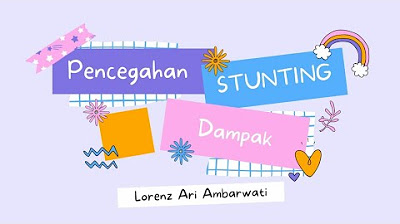#momscorner 16 Dr. dr. Meta Herdiana Hanindita, Sp.A(K).| Stunting Tidak Mengenal Sosial dan Ekonomi
Summary
TLDRThis video discusses the critical issue of stunting in children, its causes, and preventive measures. It highlights the importance of proper nutrition, particularly animal protein, and timely medical intervention. The conversation explores how stunting affects cognitive development, education, and long-term health outcomes, emphasizing the need for early intervention, especially during the first 1000 days of a child’s life. Experts stress the importance of parents ensuring adequate nutritional intake, including breast milk and appropriate complementary feeding, to prevent stunting. The video also addresses common misconceptions and provides practical advice for families, particularly in regions with limited resources.
Takeaways
- 😀 NGT (Nasogastric Tube) may be used for children with chewing or swallowing difficulties to ensure they receive proper nutrition.
- 😀 NGT should not be a long-term solution; it must be used under the guidance of a pediatrician.
- 😀 Iron deficiency anemia is common in children and should only be treated with iron supplements based on confirmed lab results, not assumptions.
- 😀 The best source of iron comes from food such as liver, red meat, and fortified products, rather than relying solely on supplements.
- 😀 Silent disease, like iron deficiency, should not be self-diagnosed or treated without proper medical advice.
- 😀 Parents should avoid the misconception that stunting is simply genetic and that children with shorter parents are not at risk.
- 😀 A low weight or weight stagnation in children, despite being active, can be an early warning sign of stunting.
- 😀 Regularly monitoring a child's weight and height and plotting their growth on a curve is crucial for tracking healthy development.
- 😀 Stunting prevention is essential for a child's future potential, and proper nutrition should be a priority during the first years of life.
- 😀 Parents should be proactive in consulting a doctor if there are any signs of growth issues, such as insufficient weight gain or short stature.
Q & A
What is Nasogastric Tube (NGT) and when is it recommended for children?
-A Nasogastric Tube (NGT) is a medical device used to provide nutrition to children who have difficulty chewing or swallowing. It is typically recommended when a child cannot meet their nutritional needs through regular eating due to oromotor skill issues, such as difficulty chewing or swallowing. The NGT ensures the child receives adequate nutrition while waiting for improvement through therapy.
What are the positive and negative aspects of using NGT for children?
-The positive aspect of using NGT is that it ensures children receive the necessary nutrition, especially when they cannot eat normally. However, the negative aspect is that prolonged use of NGT may prevent the child from recognizing hunger and fullness signals, potentially leading to a disinterest in eating. It should only be used under medical supervision and for a limited period.
Can children over the age of 2 consume iron supplements without a doctor's recommendation?
-No, children should not consume iron supplements without a doctor's recommendation. Iron is a micronutrient that is essential in small amounts, and its supplementation should be based on proper diagnosis. If laboratory tests confirm an iron deficiency, supplementation may be advised. It's best to first try to meet nutritional needs through diet, such as eating iron-rich foods like chicken liver, red meat, and fortified foods.
Why is chicken liver considered a good source of iron for children?
-Chicken liver is considered an excellent source of iron because it contains heme iron, a form of iron that is easily absorbed by the body. It's particularly beneficial for infants, especially during complementary feeding (MPASI), to ensure they receive sufficient iron.
What are some common misconceptions about stunting in children?
-A common misconception is that stunting is hereditary, meaning children with short parents will naturally be short. Another misconception is that if a child is active, their growth problems aren't a concern, even if they are underweight. In reality, these signs can be early warnings of stunting and should be addressed promptly.
What is the importance of monitoring a child's growth?
-Monitoring a child's growth, including regular measurements of weight and height, is essential to detect any signs of stunting early. This allows for timely interventions to ensure the child receives proper nutrition and care to promote healthy growth.
What is the role of fortified foods in addressing iron deficiency in children?
-Fortified foods are an important option for addressing iron deficiency when natural food sources are insufficient. These foods are enriched with additional nutrients, such as iron, to help meet the nutritional needs of children, especially when it's challenging to consume enough iron-rich foods.
How can iron deficiency in children be diagnosed?
-Iron deficiency in children can be diagnosed through laboratory tests, which measure various blood parameters such as hemoglobin levels and ferritin. These tests help identify deficiencies and guide the appropriate course of treatment, including supplementation if necessary.
What actions should parents take if they notice a child's weight or height is falling behind the norm?
-Parents should consult a doctor if they notice that their child’s weight or height is significantly below the expected range. Regularly plotting growth on a growth curve and seeking medical advice will help identify any underlying causes of poor growth or potential stunting.
What is the main goal in preventing stunting in children?
-The main goal in preventing stunting is to ensure that children grow and develop properly, both physically and mentally. This is achieved by ensuring proper nutrition, particularly during critical periods such as early childhood, and addressing any growth issues before they become permanent.
Outlines

This section is available to paid users only. Please upgrade to access this part.
Upgrade NowMindmap

This section is available to paid users only. Please upgrade to access this part.
Upgrade NowKeywords

This section is available to paid users only. Please upgrade to access this part.
Upgrade NowHighlights

This section is available to paid users only. Please upgrade to access this part.
Upgrade NowTranscripts

This section is available to paid users only. Please upgrade to access this part.
Upgrade Now5.0 / 5 (0 votes)





